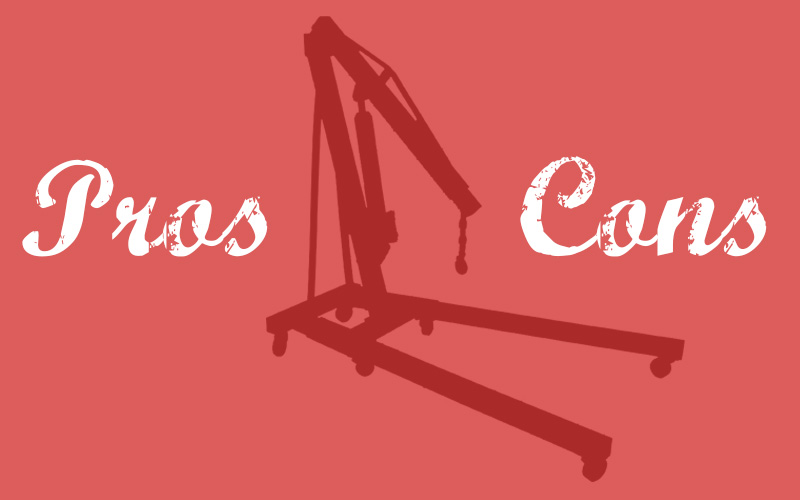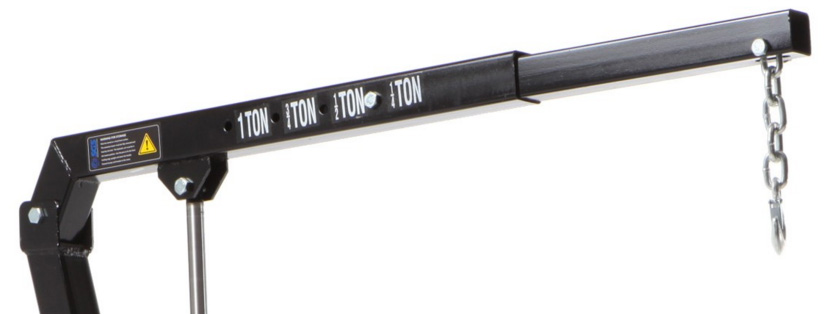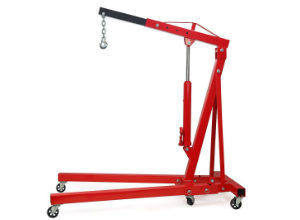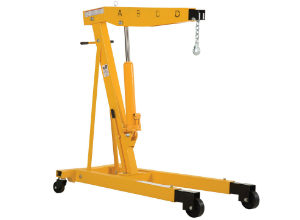Advantages and Disadvantages of a Hydraulic engine hoist
Hydraulic engine hoists are the most popular tools for lifting engines out of cars, but what are advantages and disadvantage of using these tools when compared with, for example, manual and electric chain hoists and other engine lifting methods? Lets look at different points which are important to engine lifting.
Lifting pace
Practically any type of engine you will lift out of a car will be heavier than 200 pounds (90 kg) without a transmission, so it needs a decent amount of force to lift an engine out of the engine compartment. Manual tools operated by hand such as hydraulic engine hoists and chain hoists will operate slower than automatic tools such as an electric hoist. However, major engine repairs usually take quite a long time, so waiting few minutes more to lift an engine out using a manual tool, in my opinion, is nothing to worry about. Also, when comparing hydraulic engine hoist to a manual chain hoist, hydraulic tool will still be faster to lift a heavy load than a chain hoist.
Lifting capacities
Depending on the size of an engine you need to lift, different lifting methods can be used. For example, when lifting a small 1 liter 3 cylinder or similar engine, you may use some sort of custom made lifting tool which is going to be good enough to stand the low weight of these engines. However, when you need to lift a much larger v6 or v8 engine, the tool needs to withstand much higher loads. This is where a hydraulic engine hoist is unbeatable. Hydraulic systems in general are used in equipment that needs to withstand extremely heavy loads, such as lifting cranes, different construction equipment and similar tools, because these systems are reliable, precise and effective. While you can also purchase a manual chain hoist that can lift well over 4 ton (8000 lb) heavy loads, a lot more common are hydraulic hoists. These hoists come with average lifting capacities of 2 tons (4000 lb) which will be more than enough for majority of engine blocks.
One thing you need to know is that if an engine block is located further into the engine compartment, you may need to extended the boom of an engine hoist which will lower the maximum lifting capacity of the tool. So make sure to take into account this measure, as well as the weight of the engine before purchasing an hydraulic engine hoist, as, for example, on most 2 ton (4000 lb) engine hoist the maximum lifting capacity with closed boom is 2 tons (4000 lb), but with a fully extended boom, just 1/2 ton (1000 lb).
Installation and operation area requirements
One of the largest advantages of a hydraulic engine hoist are wide variety of places the tool can be used. When talking about manual and electric chain hoists, they requite special installations or scaffolds, so a hoist hangs over the car and is able to lift the engine out of the car. Building such a system often costs a lot more than purchasing a hydraulic hoist and sometimes isn’t even possible to build, if, for example, you have limited space in your workshop.
What a hydraulic engine hoist needs to operate is a firm and level surface and that is it. You can use the tool on your garage floor, on concrete outside your garage and even on a firm ground, if wheels of the hoist does not stuck into the ground under load.
Usage and ease of use
Hydraulic engine hoists have a pretty simple structure and the operation of the tool should be clear for most, if not, all tools come with an operation manual. Today, most engine hoists are foldable and come disassembled, so they must be assembled in order to be used. This process can take from half an hour to few hours depending on the product. Some smaller hydraulic hoists with lower lifting capacities can be assembled by a single person, but larger hoists will require two persons to assemble the tool. I recommend you to ask your buddy for a help to assemble a hydraulic engine hoist, because it is going to be much quicker that way.
From the usage perspective of the hoist, there aren’t that much you can do wrong. The most important part of an engine hoist is the hydraulic jack. To lift a load you must insert the lifting handle into a handle socket and pump, which will raise the ram, boom and the load attached at the end of the boom. To lower a load, you must slowly open the bleed valve, which will let oil out of the cylinder into the reservoir and lower the load. If your hoist has got an adjustable boom or extendable legs, they can be extended or closed using a simple pin system on most tools. To attach a load to the hoist there is a grab hook on most units at the end of the boom, similar to chain hoists which also have a grab hook for attaching lifting chains, slings, a load leveler or load itself.
When talking about lifting an engine out of a car, the process in most cases will require at least two people to check that everything is going smoothly, but this is no different with other type of hoists. This process is very important, as a high load is being lifted that could potentially damage the engine and other parts of the car.
Storage
As mentioned above, today most hydraulic engine hoist are foldable, what this means it that legs of the hoist can be lifted upwards and the boom can be lowered down, so the hoist takes up a lot less space and you can just store it in the corner of your workshop or garage. You can change the position of the hoist from folded to working and back in just less than a minute. Also, because today you can buy most hoists online, they come disassembled for easier shipment, so if you have very limited amount of space, there is a possibility to fully disassemble the hoist for storage, this also is handy if you need to transform the hoist in a car or a trailer.
Hydraulic engine hoists obviously take more space than chain hoists, so if there isn’t any way you could free up approx. 5.8×3.3 feet (1.80×1 m) large area in your workshop, I suggest getting a manual chain hoists. But thanks to the possibility to fold or disassemble a hydraulic hoist, I think most repairers will find a place to store the hoist.
Maintenance and repairs
There are wide variety of hydraulic engine hoists on the market, you can buy a 2 ton engine hoist for 200 dollars or for 600 dollars, of course one for 600 dollars will have much higher quality build materials than one for 200 dollars and will require much less repairs, similar as with any other kind of product. However, most hydraulic engine hoists, if used correctly without exceeding the maximum weight limit of the tool, will work with little maintenance and repairs required. Generally, I suggest lubricating all moving parts from time to time, similar as with other mechanical tools. But the most attention needs to be addressed to the hydraulic jack, as it does the most work when lifting a load, so it also requires maintenance more often. The most common maintenance works you will need to perform for a hydraulic jack is oil change and air bleeding which both are simple to do tasks at home.
Another advantage of a hydraulic hoist is that on most units all parts can be removed and changed and majority of the largest manufacturers offer spare parts for their products, so if anything breaks on the tool, you can buy a spare part and don’t have to look for a new hoist. Also, if the manufacturer of the hoist does not offer a spare part, chances are you can find a similar engine hoist from other manufacturer, who might sell the part you need to replace, as the construction of most foldable engine hoists is pretty similar.
Price
We have came to one of the most important factors for most that are looking for an engine hoist – the price. The price for a hydraulic engine hoist can vary based on the manufacturer, quality, maximum lifting capacity and other factors, but in most cases you will have to pay significantly more for a hydraulic engine hoist, when compared to a manual chain hoist. And this is pretty obvious considering all the advantages a hydraulic engine hoist offers over a manual chain hoist. However, if you want to purchase an electric chain hoist, the price difference quickly changes, as you will have to pay a lot more for a quality electric chain hoist with capacity of at least 1 ton (2000 lb) than for a hydraulic engine hoist with a similar lifting capacity. On general, prices for hydraulic engine hoists start at 200 dollars for 1 ton (2000 lb) models and goes up to couple thousand dollars for high quality hoists used in industrial applications.
Additional resources needed to work
Because hydraulic hoists are manual tools and most of these tools do not provide any automatic functions that are powered using an electricity, these tools do not require practically any additional resources to operate. One thing you will need to purchase is a hydraulic oil for the hydraulic jack which will need to be replaced after certain period of usage, but other than that, a hydraulic engine hoist won’t require any additional resources to work, making it cheap to use and maintain.
- Floor Jack Storage Ideas and Tips - November 19, 2019
- Tips for Using a Car Jack - November 12, 2019
- How Often Should You Wash Your Car in the Winter? - November 5, 2019





Leave a Reply